You’re engaged! You must now celebrate the occasion in the appropriate way: With a party, a toast, and some bubbles.
Choosing bad Champagne for your toast is literally the easiest way to put a bad taste in the mouths of all your wedding guests, simultaneously. So, don’t. Picking the right stuff can be easy if you give up the two old stereotypes of ‘good toast taste.’ They are these:
(1) Good wine = Expensive wine
(2) Good wine = Champagne
Yes, some expensive wines are good wines (perhaps many), and yes, some Champagnes are good wine (perhaps very many), but there are more important factors you need to pay attention to. For instance: taste? Remember?
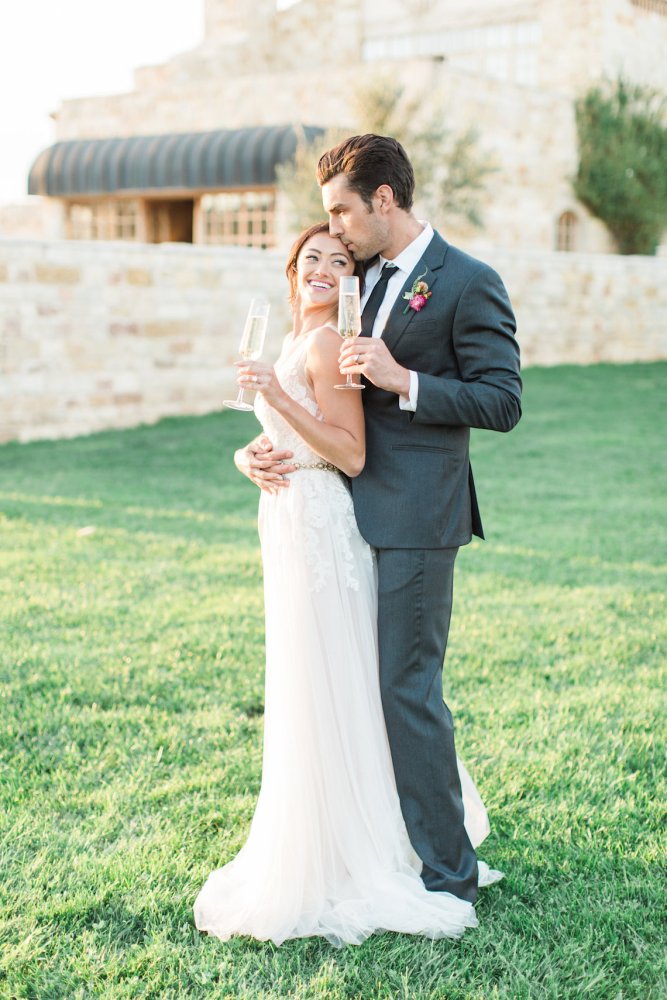
Jenny Quicksall via Bridal Musings
If not all Champagne is good, and not all expensive wine is good, how are you supposed to choose the sparkling wine that’s right for one of your life’s biggest ovations? Don’t forget, choosing the right stuff is as big a necessity as the ritual itself. The only thing your wine-snob friends will find more distasteful than tasteless bubbles are no bubbles at all. And what the heck is Prosecco, anyway? Cava?
In brief, there are 6 major names for sparkling wine that either pick out the place they are from, how they are made, or both. They are Champagne, Crémant, Prosecco, Cava, Pétillant-naturel (Pét-Nat) and Sparkling Wine.
Champagne is a region in France that is famous for inventing and producing some incredible examples of sparkling wine. Crémant is French (or Luxembourgish) sparkling wine that is made like Champagne, but not made physically in Champagne. Prosecco is sparkling wine made in Italy. Cava is sparkling wine made in Spain. Pétillant-naturel is a style of making sparkling wine that is slightly different than the traditional Champenoise method. Sparkling wine is everything else that sparkles (and is wine).
There are examples of all of these that are perfect for your engagement party or wedding, so let’s look a little closer at each and pick out pros and cons.
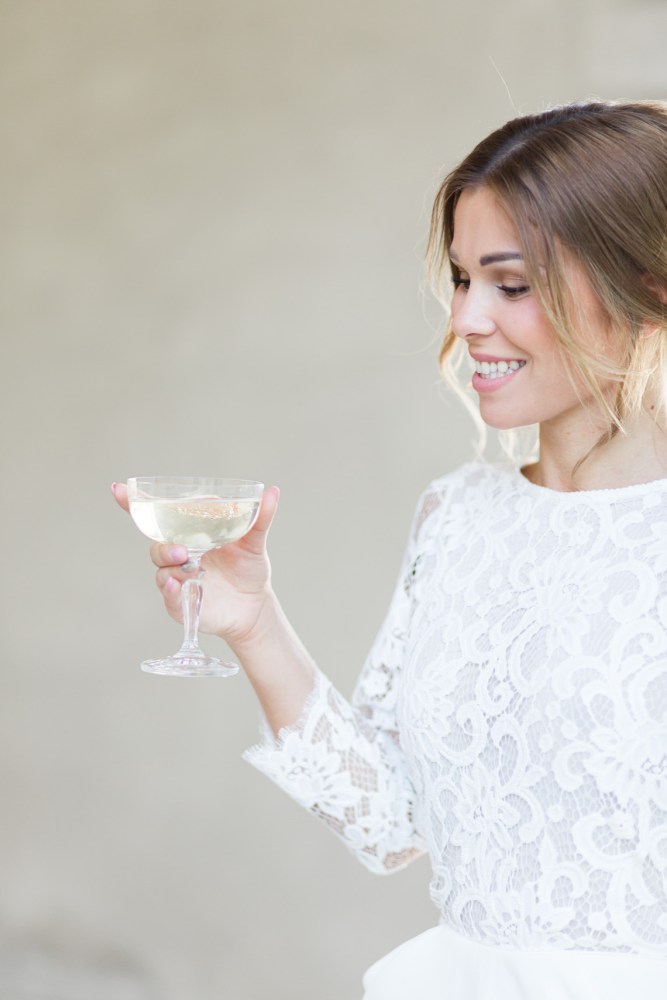
Photo by Cavin Elizabeth via Bridal Musings
Champagne
Champagne denotes a region but also a traditional style of winemaking that makes for the emblematic product we all know and love. It’s the mainstay, the standard, the Platonic ideal, and the boilerplate. It can sometimes be the very best wine, but too often its steep price is derived from its label and not the way it tastes, i.e. bad. Still, there are very good Champagnes that are not exorbitant in price, and if you have the budget, there is no classier way to treat your guests.
Typically, Champagne is a blend of Chardonnay, Pinot Noir, and Pinot Meunier. Sometimes it’s all Chardonnay (called Blanc de Blanc). Sometimes it’s all Pinot Noir (Blanc de Noir). Very rarely it is all Meunier (no fancy name). Those are names to look for if you’re partial to these grapes.
If you care about how sweet or dry you like your wine, Champagne is almost always finished off with a little liquid sugar called dosage. Essentially, the less dosage, the drier the wine. All Champagne tells you on the bottle the level of dosage. Brut Nature Champagne sees the smallest amount, or in some cases none at all. Next comes Extra Brut, Brut, Extra Dry, Dry, Demi-Sec, and Doux – all in increasing levels of sweetness. Most of the Champagne you get from the local liquor store, gallery opening, or house party will fall somewhere between Extra Brut and Brut.
My favorite Champagnes are natural “grower Champagnes” where grapes are grown by the vignerons themselves (not common) and made organically and sustainably. Vouette et Sorbee make some incredible wines for a lot cheaper than top grower Champagnes like Jacques Sellose, or Agrapart & Fils, any of which will melt your face off.
If you’re not in the market for expensive Champagne ($80 and up), then you’ll be happy to know that other sparkling categories (listed below) offer delicious wines that will far exceed the quality of $60 Veuve Clicqout or similar “big house” Champagnes, for a third of the price.

Jenny Quicksall via Bridal Musings
Crémant
For instance, wine made exactly like Champagne, that isn’t Champagne, from other fantastic terroirs. Sparkling wine is made in all your favorite regions of France: Burgundy, Loire, Bordeaux, Alsace, and even Provence.
The thing to know about Crémant, is that local varieties will often be thrown into the typical Champenoise blend. Menu Pineau, Folle Blanche, Chenin Blanc, Riesling and Sauvignon Blanc are all eligible, depending on the place of origin. So if you have a connection to another French variety besides the trinity of Champagne grapes, there is likely a Crémant for you.
Domaine Valentin Zusslin produces a number of excellent Crémants from blends of Riesling, Auxerrois and other rare, white varieties. They are also organic, biodynamic and never add sulfur to their wines. Best of all, they are half the price of any entry level Champagne, despite greater complexity, uniqueness – and frankly – taste.
Other great Crémant come from Domaine Cyrill Sevin (who also works without sulfur), and a personal favorite, Jo Landron’s “Atmophères Brut” is a value beyond compare.
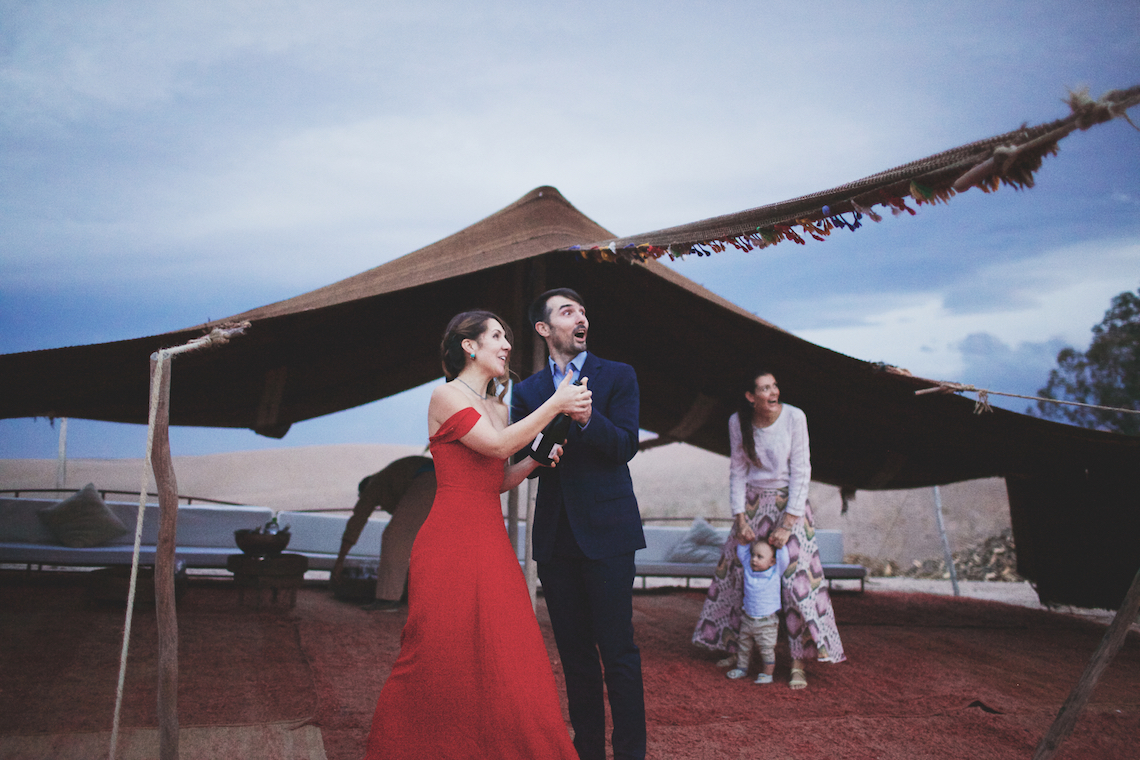
Photo by Claire Eliza via Bridal Musings
Prosecco
It isn’t all about French wine. Prosecco is now the world’s most consumed sparkling wine. And it’s no surprise given the quality and the tiny price points. Most of your guests have garnered a taste for Prosecco and will be more than happy to revisit their favorite brunch to celebrate your engagement.
Still, Prosecco is a little different from Champagne or Crémant. Prosecco is made in the Veneto district of Italy, from a grape called, Glera. This is a few miles north of Venice, around the city of Treviso. Instead of the Champenoise method, Prosecco is made with a much simpler method known as the “tank method.” The result is a creamier texture, larger bubbles, and lower acidity (making it the perfect accompaniment for the citric bite of some orange juice).
Easy, quaffable Prosecco abounds, but there are some producers making truly great Prosecco. Check out some wines from Bisson for some mindblowing examples.
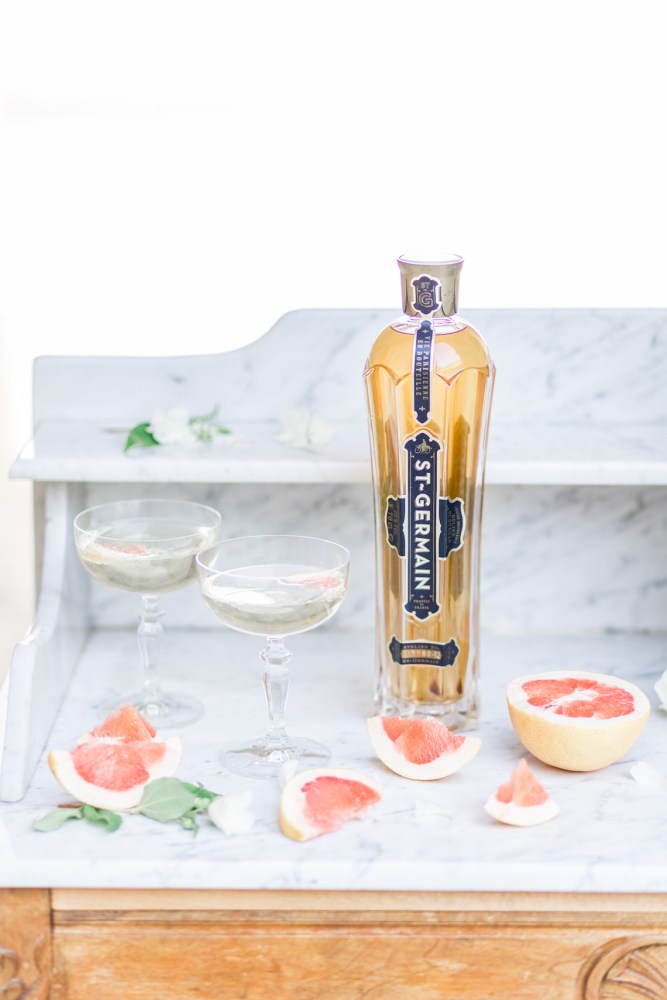
Photo by Cavin Elizabeth via Bridal Musings
Cava
The only sparkling wine that’s going to give Prosecco any competition at the cash register is Cava, the sparkling wine of Spain. You’ve probably had a lot more Cava than you think for exactly this reason. If you’re ordering sparkling wine by the glass for less than $10, it’s very likely Prosecco or Cava, the latter of which is gaining popularity at the rate Prosecco was only a few years ago.
That’s because these wines are pretty good, and unlike Prosecco, they are made in the traditional Champagnoise style. The difference comes down to grape and Terroir. The blend is typically Macabeu, Parellada, and Xarel·lo. Other grapes like Grenache, Chardonnay and Pinot make the blend as well. Cava can legally come from anywhere in Spain, but the most famous houses are in the Northeast, near Barcelona.
My favorite Cava producer, by far, is Recaredo Mata Casanovas in Catalonia. This is another natural winemaker known for long aging, rich, beautiful cava. However, like Prosecco, very fine examples abound at minuscule price points.

Photo by Claire Eliza via Bridal Musings
Pétillant-naturel (Pét-Nat)
Pét-Nat is a whole different story. Pétillant-naturel means naturally sparkling. It is a method of winemaking that predates the Champagne method but has recently had a resurgence due to the popularity of the natural wine movement.
Where a second fermentation is initiated in the Champagne method, Pét-Nats finish their fermentation in the bottle, most often with the yeasts and sediment along with the juice. The wines are thus cloudy, lower in alcohol, funky, and alive.
Pét-Nats are made everywhere, from Sicily to Long Island, but the most famous examples come from France. Rene and Agnes Mosse make a very hip example called, “Moussamoussettes” made from Gamay and Cabernet Franc. It is almost as delicious as it is fun to say. If your engagement party looks to be a more casual affair, then a wine like this one is the perfect way to dial down the bougie Champagne boozing for a wine that will not only sing in a solo cup, but impress the wine snobs as well.
Other killer examples come from Weingut Strohmeier, and Porto del Vento.
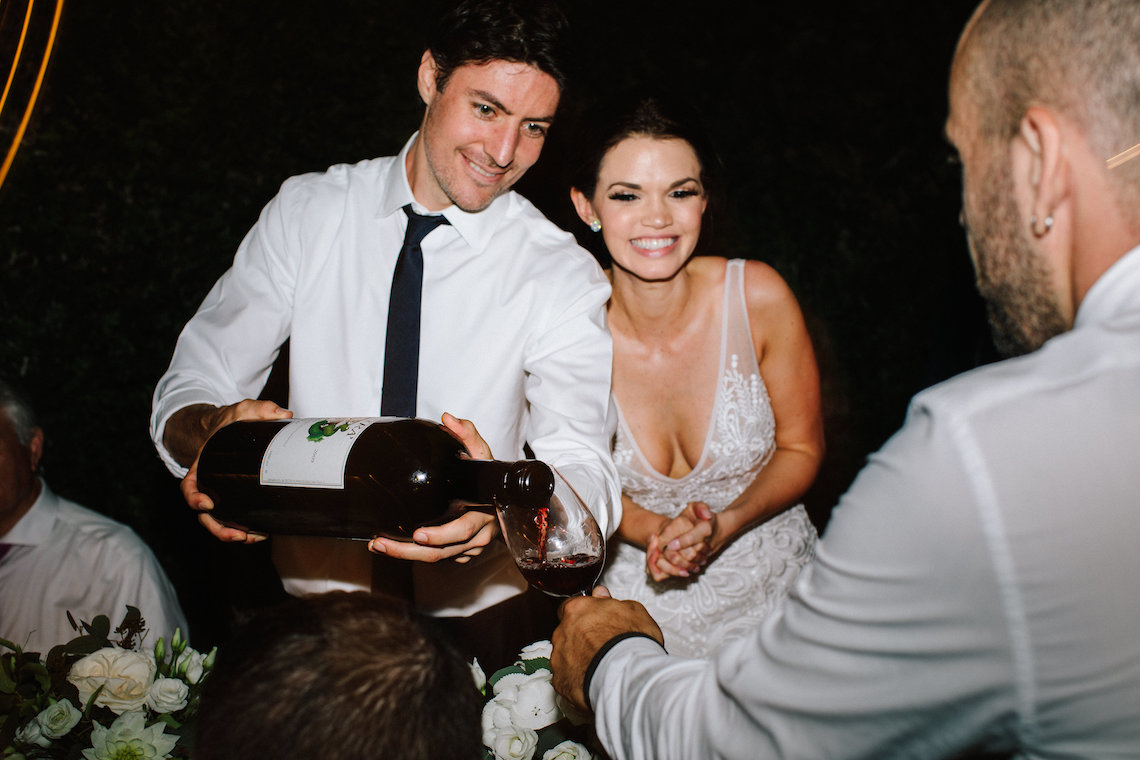
Photo by Jeff Brummett Visuals via Bridal Musings
Sparkling Wine
As for the “Other” category, there are some potential winners that fall outside our big categories. The most egregious omission is Sekt, the German sparkling wine. This is not for lack of quality, but more for lack of availability. Peter Lauer produces some incredible examples of sparkling Riesling that can sometimes be found in the states, as well as Hofgut Falkenstein.
Then there is “New World” Sparkling wine that you very often see domestic examples of. Unfortunately, many domestic sparkling wines of quality come with a premium. The one exception that proves the rule is from the Gruet Winery in New Mexico. They make a number of excellent sparkling wines for ridiculously cheap. Their reputation in the wine world is none-too-shabby either, making it a perfectly respectable budget option for an engagement party of any level of sophistication.

Photo by Claire Eliza
In the end, it’s hard to go wrong if you spend a little time tasting – trusting your palate rather than the label or the price point. And what better time than now to branch out with your betrothed and see what these different methods and regions have to offer.
